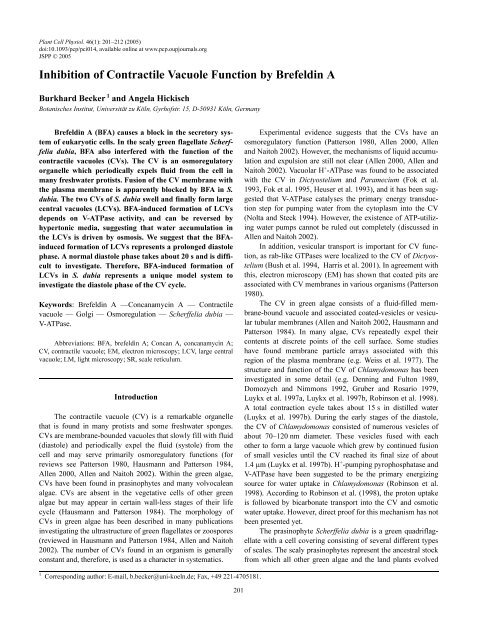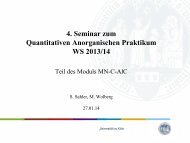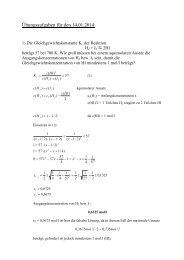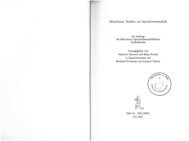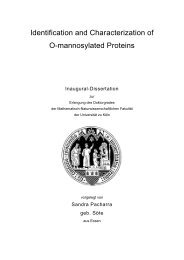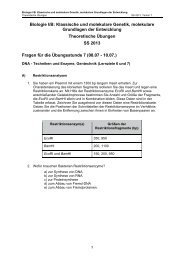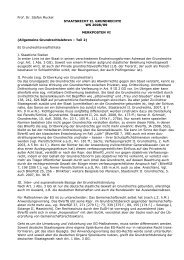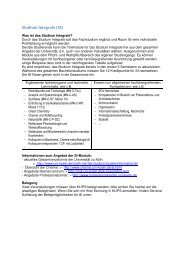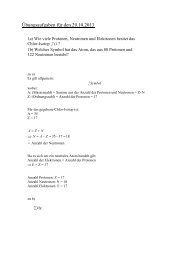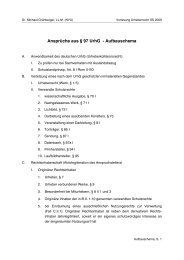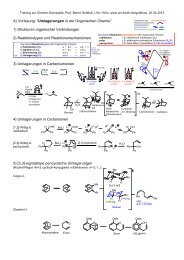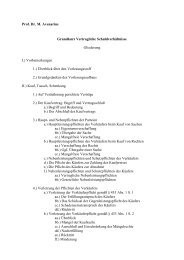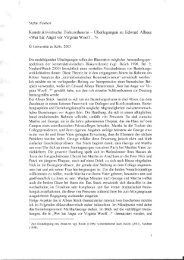Inhibition of Contractile Vacuole Function by ... - Universität zu Köln
Inhibition of Contractile Vacuole Function by ... - Universität zu Köln
Inhibition of Contractile Vacuole Function by ... - Universität zu Köln
Create successful ePaper yourself
Turn your PDF publications into a flip-book with our unique Google optimized e-Paper software.
Plant Cell Physiol. 46(1): 201–212 (2005)<br />
doi:10.1093/pcp/pci014, available online at www.pcp.oupjournals.org<br />
JSPP © 2005<br />
<strong>Inhibition</strong> <strong>of</strong> <strong>Contractile</strong> <strong>Vacuole</strong> <strong>Function</strong> <strong>by</strong> Brefeldin A<br />
Burkhard Becker 1 and Angela Hickisch<br />
Botanisches Institut, <strong>Universität</strong> <strong>zu</strong> <strong>Köln</strong>, Gyrh<strong>of</strong>str. 15, D-50931 <strong>Köln</strong>, Germany<br />
Brefeldin A (BFA) causes a block in the secretory system<br />
<strong>of</strong> eukaryotic cells. In the scaly green flagellate Scherffelia<br />
dubia, BFA also interfered with the function <strong>of</strong> the<br />
contractile vacuoles (CVs). The CV is an osmoregulatory<br />
organelle which periodically expels fluid from the cell in<br />
many freshwater protists. Fusion <strong>of</strong> the CV membrane with<br />
the plasma membrane is apparently blocked <strong>by</strong> BFA in S.<br />
dubia. The two CVs <strong>of</strong> S. dubia swell and finally form large<br />
central vacuoles (LCVs). BFA-induced formation <strong>of</strong> LCVs<br />
depends on V-ATPase activity, and can be reversed <strong>by</strong><br />
hypertonic media, suggesting that water accumulation in<br />
the LCVs is driven <strong>by</strong> osmosis. We suggest that the BFAinduced<br />
formation <strong>of</strong> LCVs represents a prolonged diastole<br />
phase. A normal diastole phase takes about 20 s and is difficult<br />
to investigate. Therefore, BFA-induced formation <strong>of</strong><br />
LCVs in S. dubia represents a unique model system to<br />
investigate the diastole phase <strong>of</strong> the CV cycle.<br />
Keywords: Brefeldin A —Concanamycin A — <strong>Contractile</strong><br />
vacuole — Golgi — Osmoregulation — Scherffelia dubia —<br />
V-ATPase.<br />
Abbreviations: BFA, brefeldin A; Concan A, concanamycin A;<br />
CV, contractile vacuole; EM, electron microscopy; LCV, large central<br />
vacuole; LM, light microscopy; SR, scale reticulum.<br />
Introduction<br />
The contractile vacuole (CV) is a remarkable organelle<br />
that is found in many protists and some freshwater sponges.<br />
CVs are membrane-bounded vacuoles that slowly fill with fluid<br />
(diastole) and periodically expel the fluid (systole) from the<br />
cell and may serve primarily osmoregulatory functions (for<br />
reviews see Patterson 1980, Hausmann and Patterson 1984,<br />
Allen 2000, Allen and Naitoh 2002). Within the green algae,<br />
CVs have been found in prasinophytes and many volvocalean<br />
algae. CVs are absent in the vegetative cells <strong>of</strong> other green<br />
algae but may appear in certain wall-less stages <strong>of</strong> their life<br />
cycle (Hausmann and Patterson 1984). The morphology <strong>of</strong><br />
CVs in green algae has been described in many publications<br />
investigating the ultrastructure <strong>of</strong> green flagellates or zoospores<br />
(reviewed in Hausmann and Patterson 1984, Allen and Naitoh<br />
2002). The number <strong>of</strong> CVs found in an organism is generally<br />
constant and, therefore, is used as a character in systematics.<br />
1 Corresponding author: E-mail, b.becker@uni-koeln.de; Fax, +49 221-4705181.<br />
201<br />
;<br />
Experimental evidence suggests that the CVs have an<br />
osmoregulatory function (Patterson 1980, Allen 2000, Allen<br />
and Naitoh 2002). However, the mechanisms <strong>of</strong> liquid accumulation<br />
and expulsion are still not clear (Allen 2000, Allen and<br />
Naitoh 2002). Vacuolar H + -ATPase was found to be associated<br />
with the CV in Dictyostelium and Paramecium (Fok et al.<br />
1993, Fok et al. 1995, Heuser et al. 1993), and it has been suggested<br />
that V-ATPase catalyses the primary energy transduction<br />
step for pumping water from the cytoplasm into the CV<br />
(Nolta and Steck 1994). However, the existence <strong>of</strong> ATP-utilizing<br />
water pumps cannot be ruled out completely (discussed in<br />
Allen and Naitoh 2002).<br />
In addition, vesicular transport is important for CV function,<br />
as rab-like GTPases were localized to the CV <strong>of</strong> Dictyostelium<br />
(Bush et al. 1994, Harris et al. 2001). In agreement with<br />
this, electron microscopy (EM) has shown that coated pits are<br />
associated with CV membranes in various organisms (Patterson<br />
1980).<br />
The CV in green algae consists <strong>of</strong> a fluid-filled membrane-bound<br />
vacuole and associated coated-vesicles or vesicular<br />
tubular membranes (Allen and Naitoh 2002, Hausmann and<br />
Patterson 1984). In many algae, CVs repeatedly expel their<br />
contents at discrete points <strong>of</strong> the cell surface. Some studies<br />
have found membrane particle arrays associated with this<br />
region <strong>of</strong> the plasma membrane (e.g. Weiss et al. 1977). The<br />
structure and function <strong>of</strong> the CV <strong>of</strong> Chlamydomonas has been<br />
investigated in some detail (e.g. Denning and Fulton 1989,<br />
Domozych and Nimmons 1992, Gruber and Rosario 1979,<br />
Luykx et al. 1997a, Luykx et al. 1997b, Robinson et al. 1998).<br />
A total contraction cycle takes about 15 s in distilled water<br />
(Luykx et al. 1997b). During the early stages <strong>of</strong> the diastole,<br />
the CV <strong>of</strong> Chlamydomonas consisted <strong>of</strong> numerous vesicles <strong>of</strong><br />
about 70–120 nm diameter. These vesicles fused with each<br />
other to form a large vacuole which grew <strong>by</strong> continued fusion<br />
<strong>of</strong> small vesicles until the CV reached its final size <strong>of</strong> about<br />
1.4 µm (Luykx et al. 1997b). H + -pumping pyrophosphatase and<br />
V-ATPase have been suggested to be the primary energizing<br />
source for water uptake in Chlamydomonas (Robinson et al.<br />
1998). According to Robinson et al. (1998), the proton uptake<br />
is followed <strong>by</strong> bicarbonate transport into the CV and osmotic<br />
water uptake. However, direct pro<strong>of</strong> for this mechanism has not<br />
been presented yet.<br />
The prasinophyte Scherffelia dubia is a green quadriflagellate<br />
with a cell covering consisting <strong>of</strong> several different types<br />
<strong>of</strong> scales. The scaly prasinophytes represent the ancestral stock<br />
from which all other green algae and the land plants evolved
202<br />
(Nakayama et al. 1998, Chapman and Waters 2002). The flagella<br />
are covered <strong>by</strong> three different types <strong>of</strong> non-mineralized<br />
scales referred to as pentagonal, man (double, rod-shaped) and<br />
hair scales based on their shapes as revealed <strong>by</strong> scanning electron<br />
microscopy (SEM) and transmission electron microscopy<br />
(TEM) (Melkonian and Preisig 1986, Becker et al. 1990). The<br />
cell body is covered <strong>by</strong> a cell wall derived ontogenetically from<br />
scales which coalesce extracellularly to form a cell wall called<br />
a theca (McFadden et al. 1986, Melkonian and Preisig 1986).<br />
Scales consist mainly <strong>of</strong> carbohydrates (Becker et al. 1991) and<br />
are synthesized in the Golgi complex (Melkonian et al. 1991,<br />
Becker et al. 1994). In vivo, the biogenesis <strong>of</strong> scales is<br />
restricted to cell division. However, biogenesis <strong>of</strong> flagellar<br />
scales can be induced <strong>by</strong> experimental amputation <strong>of</strong> the flagella.<br />
Upon deflagellation, cells regenerate new flagella including<br />
their scaly covering. Using this experimental system, the<br />
anterograde transport <strong>of</strong> scales through the Golgi complex in S.<br />
The contractile vacuole <strong>of</strong> S. dubia<br />
Fig. 1 Structure <strong>of</strong> the contractile vacuole in S.<br />
dubia as revealed <strong>by</strong> standard TEM. (A) Longitudinal<br />
section through a flagellar regenerating<br />
cell <strong>of</strong> S. dubia. (B) Higher magnification <strong>of</strong> the<br />
CV region from a different cell. (C) Higher magnification<br />
<strong>of</strong> the flagella groove <strong>of</strong> the cell shown<br />
in (A), showing two growing flagella covered<br />
with scales. (D–I) Early diastole phase: the scale<br />
reticulum started to swell. The micrographs in<br />
(D–G) and (H and I) represent consecutive sections<br />
from the same cell, respectively. (K) Beginning<br />
systole: a round vacuole discharged its<br />
contents into the flagellar groove. Coated pits are<br />
marked with arrows and pentagonal scales are<br />
marked with arrowheads. bb, basal body; c, chloroplast;<br />
cv, contractile vacuole; cw, cell wall; f,<br />
flagellum; g, Golgi stack; m, mitochondrion; n,<br />
nucleus; sr, scale reticulum. Bar = 0.5 µm.<br />
dubia has been studied in detail (McFadden and Melkonian<br />
1986a, McFadden et al. 1986, Becker et al. 1995, Perasso et al.<br />
2000) and the results have contributed to the renaissance <strong>of</strong> the<br />
cisternal progression model now called the cisternal maturation<br />
model <strong>of</strong> intra-Golgi transport (Nebenführ 2003).<br />
The fungal macrocyclic lactone brefeldin A (BFA) is a<br />
commonly used inhibitor <strong>of</strong> protein secretion and Golgi function<br />
in plant and mammalian cells (reviewed in Nebenführ et<br />
al. 2002). When we treated S. dubia cells with BFA, we<br />
observed that BFA interfered as expected with the structure and<br />
function <strong>of</strong> the Golgi complex and, more surprisingly, with the<br />
function <strong>of</strong> the CV. The two CVs swelled and finally formed<br />
large central vacuoles (LCVs). We propose that BFA-induced<br />
formation <strong>of</strong> LCVs in S. dubia represents a prolonged diastole<br />
phase <strong>of</strong> the CV cycle. Therefore, BFA-dependent formation <strong>of</strong><br />
the large vacuole might <strong>of</strong>fer a unique possibility to investigate<br />
the diastole phase <strong>of</strong> a CV cycle in detail.
Fig. 2 BFA interferes with the function <strong>of</strong> the CV. Upon addition <strong>of</strong><br />
BFA to S. dubia cells, the two CVs swell (B, 5 min <strong>of</strong> BFA treatment)<br />
and form a large central vacuole (LCV) at later stages (C, 10 min <strong>of</strong><br />
BFA treatment). (A) Control cells as seen in the light microscope. (D)<br />
The rate <strong>of</strong> formation <strong>of</strong> LCVs depends on the temperature <strong>of</strong> the<br />
medium.<br />
Results<br />
Structure <strong>of</strong> the contractile vacuole in Scherffelia dubia<br />
When S. dubia cells were observed with the light microscope<br />
(LM) in culture medium (5 mosM), two CVs were easily<br />
detected near the anterior end <strong>of</strong> the cell on both sides <strong>of</strong> the<br />
flagellar groove (see Fig. 2A for a light micrograph <strong>of</strong> a S.<br />
dubia cell). The two CVs tended to alternate in their contractions,<br />
with an average interval <strong>of</strong> 22.3 ± 3.5 s (n = 15, value<br />
based on video recordings <strong>of</strong> single cells). However, in a few<br />
cases, considerably shorter or longer contraction intervals were<br />
observed (as short as 9 s and as long as 30 s), which sometimes<br />
led to almost simultaneous contraction cycles. Each CV<br />
The contractile vacuole <strong>of</strong> S. dubia 203<br />
reached a maximum size <strong>of</strong> 1.4 ± 0.1 µm (n = 15) at the end <strong>of</strong><br />
diastole.<br />
The ultrastructure <strong>of</strong> the CV was investigated in chemically<br />
fixed cells (see Melkonian and Preisig 1986 for a detailed<br />
description <strong>of</strong> the ultrastructure <strong>of</strong> S. dubia). At the end <strong>of</strong> diastole,<br />
the CV consisted <strong>of</strong> a single vacuole with a smooth membrane<br />
(Fig. 1A, B). At this stage <strong>of</strong> the CV cycle, we never<br />
observed coated pits on the CV membrane. Sometimes pentagonal<br />
scales (underlayer scales associated with the flagellar<br />
membrane, see Fig. 1C, arrowheads) were found to be present<br />
on the inner surface <strong>of</strong> the CV. The number <strong>of</strong> pentagonal<br />
scales within the CV is low in interphase cells, when cells do<br />
not synthesize flagellar scales (Table 1). In contrast, in CVs <strong>of</strong><br />
cells in which flagella biosynthesis (including biogenesis <strong>of</strong><br />
scales) has been induced <strong>by</strong> experimental amputation, we<br />
observed a significant number <strong>of</strong> pentagonal scales (Table 1).<br />
The two other scale types present on the flagella <strong>of</strong> S. dubia<br />
were never observed within the CV.<br />
In addition to the single vacuole representing the CV at<br />
late diastole, a membranous reticulum containing numerous<br />
coated pits (Fig. 1, arrows) is present in the CV region. In tangential<br />
sections, the coated pits display honeycomb-like structures<br />
typical for clathrin-coated pits (Melkonian and Preisig<br />
1986). Coated pits <strong>of</strong>ten contain pentagonal scales (Fig. 1,<br />
arrowheads). For this reason, the membrane reticulum was<br />
called the scale reticulum (SR) <strong>by</strong> Melkonian and Preisig<br />
(1986). At the beginning <strong>of</strong> the diastole, the SR swelled (Fig. 1<br />
D–I; note the coated pits containing pentagonal scales indicated<br />
<strong>by</strong> arrowheads) before a large round vacuole was formed (Fig.<br />
1A, B). During systole (lasting 1–2 s, based on video recordings),<br />
the CV discharged its contents into the flagellar groove<br />
(Fig. 1K). No small vacuoles similar to the situation in<br />
Chlamydomonas (Luykx et al. 1997b), or a collapsed large vacuole<br />
were found within the CV region (Fig. 1A, B). The only<br />
other membranous organelle observed in the CV region was the<br />
SR, indicating that the SR might be part <strong>of</strong> the CV complex <strong>of</strong><br />
Scherffelia. However, a continuity <strong>of</strong> the SR with the round<br />
Table 1 Number <strong>of</strong> pentagonal scales observed in contractile vacuoles (interphase and flagellar regenerating cells) and large central<br />
vacuoles (BFA-treated flagellar regenerating cells).<br />
No. <strong>of</strong> CVs or<br />
LCVs analysed<br />
No. <strong>of</strong> pentagonal<br />
scales observed<br />
µm 2 membrane<br />
analysed<br />
No. <strong>of</strong> scales per µm 2 CV or<br />
LCV membrane surface a<br />
Control cells 14 2 3.18 0.6 ± 1.6<br />
Flagellar regenerating cells 11 22 2.33 9.2 ± 6.5<br />
5min BFA b 7 9 5.1 4.8 ± 3.0<br />
10 min BFA b 11 25 6.9 3.6 ± 2.4<br />
15 min BFA b 6 11 4.3 2.9 ± 2.0<br />
20 min BFA b 6 8 4.5 1.5 ± 2.3<br />
30 min BFA b 4 5 3.3 1.5 ± 1.1<br />
a 2 2<br />
The number <strong>of</strong> scales per µm <strong>of</strong> membrane surface was calculated for each CV. The average number <strong>of</strong> scales per µm <strong>of</strong> membrane surface and<br />
the SD are given.<br />
b<br />
BFA was added 20 min after experimental deflagellation.
204<br />
vacuole at late diastole stages was never observed even when<br />
serial sections were used to investigate a larger surface area <strong>of</strong><br />
the CV (data not shown).<br />
Effect <strong>of</strong> BFA on the contractile vacuole<br />
Upon addition <strong>of</strong> BFA to S. dubia cells, the two CVs<br />
failed to expel liquid and swelled (Fig. 2B, 5 min <strong>of</strong> BFA treatment,<br />
video 1 <strong>of</strong> the Supplementary material) which is accompanied<br />
<strong>by</strong> an increase in total cell volume indicating the uptake<br />
<strong>of</strong> water <strong>by</strong> the cell (see video 1 <strong>of</strong> the Supplementary material).<br />
About 10 min after BFA addition, the cells lost their flagella.<br />
Finally, >90% <strong>of</strong> the cells developed an apparent single<br />
LCV (Fig. 2C, video 1 <strong>of</strong> the Supplementary material). Within<br />
30 min, the LCV reached an average diameter <strong>of</strong> 6.7 ± 1.3 µm<br />
(n = 20). A few cells (maximum 10% <strong>of</strong> the cell population)<br />
remained motile and completely unaffected <strong>by</strong> BFA treatment<br />
as judged <strong>by</strong> LM.<br />
The formation <strong>of</strong> an LCV was completely reversible<br />
(tested for up to 1 h <strong>of</strong> BFA treatment at 15°C, data not shown).<br />
BFA-induced formation <strong>of</strong> an LCV was temperature dependent.<br />
At 0°C (cells incubated with BFA on ice), no LCVs were<br />
The contractile vacuole <strong>of</strong> S. dubia<br />
Fig. 3 Electron microscopic analysis <strong>of</strong> the BFAinduced<br />
formation <strong>of</strong> large central vacuoles (LCVs).<br />
Flagellar regeneration was induced <strong>by</strong> experimental<br />
amputation and the cells allowed to regenerate flagella<br />
for 20 min before BFA was added. Cells were<br />
treated for the indicated time with BFA and processed<br />
for standard TEM. (A and B) After 5 min <strong>of</strong><br />
BFA treatment. (A) Longitudinal section through a<br />
cell and (B) a cross-section <strong>of</strong> a cell: the CV was<br />
enlarged, showed an irregular appearance and coated<br />
pits (arrows) are associated with the enlarged CV.<br />
(C) After 10 min <strong>of</strong> BFA treatment: a round vacuole<br />
is formed. (D) After 15 min <strong>of</strong> BFA treatment. (E)<br />
After 30 min <strong>of</strong> BFA treatment. bb, basal body; c,<br />
chloroplast; cv, contractile vacuole; g, Golgi stack;<br />
lcv, large central vacuole; n, nucleus; v, putative<br />
polyphosphate-containing vacuole. Bar = 0.5 µm.<br />
formed at all (Fig. 2D) and in cells incubated with BFA at 15°C<br />
the formation <strong>of</strong> LCVs was significantly slower when compared<br />
with cells treated with BFA at 25°C (Fig. 2D).<br />
Ultrastructure <strong>of</strong> the CV in BFA-treated S. dubia cells<br />
Cells were deflagellated and incubated for 20 min at 20°C<br />
in culture medium before BFA was added. During the incubation<br />
time (without BFA), the cells started to regenerate new<br />
flagella and synthesized new flagellar scales (see Fig. 4A). At<br />
20 min after deflagellation, all Golgi cisternae contain scales<br />
except for the two to three cis-most cisternae (see below for<br />
details). Cells were chemically fixed and processed for EM<br />
prior to addition <strong>of</strong> BFA and 5, 10, 15, 20 and 30 min after adding<br />
BFA. As a control, methanol alone was added 20 min after<br />
deflagellation and cells were fixed for EM after 15 and 30 min<br />
incubation time, respectively. No effect on the ultrastructure <strong>of</strong><br />
S. dubia cells was observed in the control samples (not shown).<br />
Cells fixed at 5 min after addition <strong>of</strong> BFA contained<br />
enlarged CVs <strong>of</strong> an irregular geometry (Fig. 3A, B). In contrast<br />
to control cells, numerous coated pits are associated with<br />
the CV <strong>of</strong> BFA-treated cells (Fig. 3C, arrows). At 10 min after
addition <strong>of</strong> BFA, the CVs were larger and had a more round<br />
geometry (Fig. 3D). Only a few coated pits associated with the<br />
CVs were observed. EM <strong>of</strong> later stages showed either a single<br />
LCV (Fig. 3E, 15 min), which is in agreement with the LM<br />
observations, or two LCVs (Fig. 3F, 30 min). Most probably,<br />
cells always contained two LCVs which could not be resolved<br />
<strong>by</strong> LM (see also below). In cells treated with BFA for >15 min,<br />
only remnants <strong>of</strong> the SR were observed, indicating that the SR<br />
was mainly adsorbed into the LCV. The number <strong>of</strong> pentagonal<br />
scales per µm 2 <strong>of</strong> the LCV membrane decreased with BFA<br />
The contractile vacuole <strong>of</strong> S. dubia 205<br />
Table 2 Effect <strong>of</strong> BFA on the structure <strong>of</strong> the Golgi complex in S. dubia<br />
Fig. 4 BFA affects the structure <strong>of</strong> the<br />
Golgi complex in S. dubia. Flagellar regeneration<br />
<strong>of</strong> S. dubia cells was induced <strong>by</strong><br />
experimental amputation and the cells<br />
allowed to regenerate flagella for 20 min<br />
before BFA was added. Cells were treated<br />
for the indicated time with BFA and processed<br />
for standard TEM. (A) Cells were<br />
fixed 20 min after deflagellation. A longitudinal<br />
section is shown. The Golgi stack is<br />
filled with scales (arrowheads). At the rim<br />
<strong>of</strong> the stack, numerous transition vesicles<br />
can be seen (small arrows). All types <strong>of</strong><br />
scales are transported within the same vesicles<br />
to the flagellar surface (arrow). (B)<br />
Cells were treated with BFA for 5 min<br />
before they were chemically fixed and processed<br />
for EM. The number <strong>of</strong> Golgi cisternae<br />
is reduced and only few transition<br />
vesicles can be seen. The arrow points to a<br />
vesicular tubular element which seems to<br />
leave the stack. (C) After 10 min <strong>of</strong> BFA<br />
treatment. The number <strong>of</strong> cisternae has<br />
decreased further and all cisternae contain<br />
scales (arrowheads). Numerous vesicles <strong>of</strong><br />
150 nm in diameter accumulate at the cisface<br />
<strong>of</strong> the stack (arrows). bb, basal body; c,<br />
chloroplast; g, Golgi stack; f, flagellum; lcv,<br />
large central vacuole; m, mitochondrion; n,<br />
nucleus; sr, scale reticulum. Bar = 1 µm.<br />
incubation time (Table 1), indicating that the membrane source<br />
for LCV growth had a lower scale content than the CV and<br />
‘diluted’ the number <strong>of</strong> scales per µm 2 <strong>of</strong> membrane in the<br />
LCV. Similar results were obtained when interphase cells (no<br />
flagellar regeneration) were treated with BFA.<br />
Ultrastructure <strong>of</strong> the Golgi complex in BFA-treated cells<br />
Beside affecting the structure <strong>of</strong> the CV, BFA also induced<br />
changes in the structure <strong>of</strong> the Golgi complex <strong>of</strong> S. dubia. In<br />
flagellar regenerating cells <strong>of</strong> S. dubia, the two Golgi stacks<br />
Control cells 5 min BFA 10 min BFA<br />
No. <strong>of</strong> stacks analysed 24 17 15<br />
No. <strong>of</strong> cisternae a<br />
14.3 ± 0.8 11.6 ± 1.1 8.3 ± 1.2<br />
No. <strong>of</strong> trans-cisternae containing scales a 11.3 ± 0.7 10.5 ± 1.1 8.0 ± 1.3<br />
No. <strong>of</strong> transition vesicles/stack a 10.6 ± 3.3 0.7 ± 1.1 0<br />
Cells were deflagellated and allowed to regenerate for 20 min before BFA was added. Cells were fixed and<br />
processed for EM prior to and 5 or 10 min after addition <strong>of</strong> BFA.<br />
a Only clear cross-sections <strong>of</strong> Golgi stacks were analysed.
206<br />
contained about 14 cisternae <strong>of</strong> about 1.5 µm diameter (Fig.<br />
4A, Table 2). The cisternae were filled with flagellar scales<br />
(arrowheads) except for the two or three cis-most cisternae<br />
which are generally devoid <strong>of</strong> any scales (Fig. 4A). Numerous<br />
transition vesicles (most probably COP1) can be see at the rim<br />
<strong>of</strong> the stack (Fig. 4A, small arrows, Table 2). Secretory vesicles<br />
containing all three types <strong>of</strong> scales transport the scales to<br />
the cell surface (Fig. 4A, arrow). Upon addition <strong>of</strong> BFA, the<br />
number <strong>of</strong> transition vesicles dropped within 5 min (Table 2,<br />
Fig. 4B) and the number <strong>of</strong> cisternae decreased from 14 to<br />
eight within the first 10 min (Table 2, Fig. 4B, C). At 10 min<br />
after addition <strong>of</strong> BFA, all remaining cisternae including the cismost<br />
cisternae contained scales (Table 2, Fig. 4C). At the cisface<br />
<strong>of</strong> the stack, numerous small vacuoles (150 nm diameter,<br />
arrows) accumulate. No further reduction <strong>of</strong> the number <strong>of</strong> cisternae<br />
could be observed at longer BFA incubation times (e.g.<br />
the Golgi stack in Fig. 3D contains seven cisternae after 15 min<br />
<strong>of</strong> BFA treatment). However, after 15 min, the overall structure<br />
<strong>of</strong> the cells was affected strongly <strong>by</strong> the growing LCV<br />
(Fig. 3D, E). Therefore, it is difficult to rule out that the growing<br />
LCVs inhibited a further BFA effect on the structure <strong>of</strong> the<br />
Golgi complex. So far, we have not been able to find any conditions<br />
which uncouple both BFA effects and would allow<br />
investigation <strong>of</strong> the BFA effect on the Golgi structure without<br />
affecting the CV, and vice versa.<br />
V-ATPase activity is required for the formation <strong>of</strong> a LCV<br />
V-ATPase function is required for CV function in many<br />
organisms (summarized in Allen 2000, Allen and Naitoh<br />
2002). To test whether V-ATPase activity is also required for<br />
the formation <strong>of</strong> LCVs, cells were treated with BFA and/or the<br />
V-ATPase-specific inhibitor concanamycin A (Concan A).<br />
Concan A turned out to be very toxic for S. dubia, and cells<br />
were dead within 15 min when treated with 1.5 µM (as judged<br />
<strong>by</strong> LM). We were not able to observe any CV activity in cells<br />
treated with Concan A. Due to the loss <strong>of</strong> CV activity, cells<br />
The contractile vacuole <strong>of</strong> S. dubia<br />
Fig. 5 TEM analysis <strong>of</strong> the effect <strong>of</strong> Concan<br />
A on cells <strong>of</strong> S. dubia. Cells were treated<br />
with Concan A and chemically fixed and<br />
processed for electron microscopy. (A and<br />
B) Longitudinal sections. (C) Cross-section.<br />
Arrows point to numerous transition vesicles<br />
seen at the periphery <strong>of</strong> the Golgi stack.<br />
bb, basal body; c, chloroplast; g, Golgi stack;<br />
f, flagellum; m, mitochondrion; n, nucleus;<br />
sr, scale reticulum. Bar = 1 µm.<br />
treated with Concan A first swelled and finally burst (not<br />
shown), explaining the toxicity <strong>of</strong> Concan A observed. Cells<br />
were viable in the presence <strong>of</strong> Concan A when 100 mM<br />
sucrose was added to the medium (not shown). Under these<br />
conditions, the cells remained motile although many cells<br />
showed plasmolysis (see also below). EM confirmed the light<br />
microscopic observations. In cells treated with Concan A for<br />
10 min, not a single filled CV was detectable (Fig. 5A) and the<br />
structure <strong>of</strong> the Golgi stacks was altered (Fig. 5). The number<br />
<strong>of</strong> cisternae increased and the trans-cisternae showed a strong<br />
Fig. 6 V-ATPase function is required for BFA-induced LCV formation.<br />
Cells were treated with BFA or with BFA and Concan A for 5 or<br />
10 min, fixed with osmium tetroxide and observed with a light microscope.<br />
(A) After 5 min <strong>of</strong> BFA treatment. (B) After 5 min <strong>of</strong> BFA and<br />
Concan A teatment. (C) After 10 min <strong>of</strong> BFA treatment. (D) After<br />
10 min <strong>of</strong> BFA and Concan A treatment.
Fig. 7 The CVs and the LCVs do not accumulate Neutral Red. Neutral<br />
Red-stained living cells were viewed in the bright field light<br />
microscope. Neither the CV (A) nor the LCV (B) are acidic enough for<br />
a significant accumulation <strong>of</strong> Neutral Red. Numerous small vesicles<br />
can be stained with Neutral Red (A and B), which are probably identical<br />
to the putative polyphosphate-containing vacuoles surrounding the<br />
nucleus (compare A and E). (A) Control cells. (B) Cells treated with<br />
BFA for 20 min. (C) Electron micrograph <strong>of</strong> control cells processed<br />
for standard TEM. N, nucleus; v, putative polyphosphate-containing<br />
vacuole. Bar = 0.5 µm.<br />
concave curvature (Fig. 5A). In many sections, the trans-cisternae<br />
appeared as a multilamellated vesicular structure (Fig. 5A,<br />
B). The formation <strong>of</strong> transition vesicles at the periphery <strong>of</strong> the<br />
Golgi stacks was not affected (Fig. 5C).<br />
When cells were treated with BFA and Concan A for 5 or<br />
10 min, no LCV was formed (Fig. 6A–D). Cells lost their flagella<br />
but the overall structure <strong>of</strong> the cells was not affected (Fig.<br />
6B, D). We conclude that V-ATPase activity is required for<br />
BFA-induced formation <strong>of</strong> LCVs, for CV function and for<br />
maintenance <strong>of</strong> the structure <strong>of</strong> the Golgi complex in S. dubia.<br />
The requirement for V-ATPase activity for CV function<br />
and formation <strong>of</strong> LCVs led us to investigate whether CVs and<br />
LCVs are acidic organelles. Control cells and BFA-treated cells<br />
were incubated with Neutral Red and observed <strong>by</strong> LM. Neither<br />
The contractile vacuole <strong>of</strong> S. dubia 207<br />
the CV (Fig. 7A) nor the LCV (Fig. 7 B) was significantly<br />
stained with Neutral Red. Instead, numerous small vacuoles<br />
mainly with a perinuclear position accumulated Neutral Red<br />
(Fig. 7A, B). The Neutral Red-containing vacuoles occupy the<br />
same position in a cell as the putative polyphosphate-containing<br />
vacuoles (compare Fig. 7A and C) described <strong>by</strong> Melkonian<br />
and Preisig (1986).<br />
Effect <strong>of</strong> the osmolarity <strong>of</strong> the medium on the formation <strong>of</strong> LCVs<br />
To investigate the effect <strong>of</strong> the external medium on the<br />
formation <strong>of</strong> LCVs, S. dubia cells were pre-incubated with a<br />
sucrose (60–160 mM)-containing medium for 15 min (Fig.<br />
8A). Many cells (67 ± 8%, n = 12) showed plasmolysis when<br />
incubated with 100 mM sucrose, indicating that the osmolarity<br />
<strong>of</strong> the cytosol is generally less than 100 mosM (Fig. 8, arrows).<br />
Since this value is rather low, we determined the cytosolic<br />
osmolarity directly. The method <strong>of</strong> Stoner and Dunham (1970)<br />
as described <strong>by</strong> Stock et al. (2001) was used (see Materials and<br />
Methods for details). Direct measurement <strong>of</strong> the cytosolic<br />
osmolarity in a cell pellet gave a mean value <strong>of</strong> 93.1 ±<br />
0.4 mOsmol (n = 3) which is in good agreement with the plasmolysis<br />
data.<br />
BFA was then added to the cells incubated for 15 min with<br />
100 mM sucrose and the cells were incubated for another<br />
30 min with BFA before fixation with osmium tetroxide. BFAinduced<br />
formation <strong>of</strong> LCVs was inhibited <strong>by</strong> external sucrose<br />
concentrations (Fig. 8B, C). An external sucrose concentration<br />
<strong>of</strong> 100 mM inhibited the formation <strong>of</strong> LCV to 90% (Fig. 8B),<br />
but many cells still displayed swollen CVs. At higher concentrations<br />
<strong>of</strong> sucrose, most cells did not display swollen CVs<br />
(Fig. 8C). Identical results were obtained when NaCl instead <strong>of</strong><br />
sucrose was used as osmoticum.<br />
To test whether the LCVs are maintained under hyperosmotic<br />
conditions, S. dubia cells were pre-incubated with BFA<br />
for 30 min and then incubated with BFA/sucrose (100–<br />
200 mM) for another 30 min before fixation with osmium<br />
Fig. 8 BFA-induced formation <strong>of</strong> the LCV can be<br />
inhibited (A–C) and reversed (D–E) <strong>by</strong> a hypertonic<br />
medium. (A) Cells were treated with sucrose for 15 min.<br />
Arrows indicate cells displaying plasmolysis. (B and C)<br />
Cells were pre-incubated with sucrose (B, 100 mM; C,<br />
160 mM) for 15 min and then with sucrose and BFA for<br />
30 min. (D) Cells were incubated with BFA for 30 min.<br />
(E and F) Cells were pre-incubated with BFA for 30 min<br />
followed <strong>by</strong> a 30 min incubation with BFA/sucrose (E,<br />
120 mM sucrose; F, 180 mM sucrose).
208<br />
Fig. 9 BFA inhibits the CV in various prasinophyte algae. In T. cordiformis,<br />
BFA also caused the formation <strong>of</strong> a LCV (A and B). In P.<br />
tetrarhynchus, the cells swelled and finally burst after addition <strong>of</strong><br />
BFA, indicating that BFA also interfered with CV function in P. tetrarhynchus<br />
(C and D). (E) BFA also interfered with CV function in M.<br />
viride. Single frames <strong>of</strong> a time-lapse video showing the swelling <strong>of</strong><br />
two Mesostigma cells in the presence <strong>of</strong> BFA are shown. Numbers<br />
refer to the time elapsed since addition <strong>of</strong> BFA.<br />
tetroxide. After pre-incubation with BFA, the cells showed the<br />
typical LCVs (Fig. 8D). When sucrose (120 mM) was added,<br />
the LCV shrunk (compare Fig. 8D and E, video 2 <strong>of</strong> the Supplementary<br />
material) and, at higher concentrations <strong>of</strong> sucrose,<br />
cells displayed even smaller LCVs, two vacuoles or no vacuole<br />
at all (Fig. 8F). In summary, the results presented indicate<br />
that BFA-induced swelling <strong>of</strong> CVs can take place under hyperosmotic<br />
conditions (Fig. 8B) and that LCVs shrink under<br />
strong hyperosmotic conditions (Fig. 8D and E).<br />
BFA effect on the contractile vacuole in other algae<br />
To our knowledge, a BFA effect on the CV has never been<br />
reported before. Therefore, we investigated whether BFA (1 µg<br />
ml –1 ) had a similar effect on other prasinophyte algae. In the<br />
closely related genus Tetraselmis cordiformis, the only known<br />
freshwater Tetraselmis species, BFA also caused the formation<br />
<strong>of</strong> a LCV (Fig. 9A, B). In Pyramimonas tetrarhynchus, the<br />
cells swelled (Fig. 9C, D) and finally burst after addition <strong>of</strong><br />
BFA, indicating that BFA also interfered with CV function in<br />
Pyramimonas. In contrast, no effect <strong>of</strong> BFA on the CV <strong>of</strong><br />
The contractile vacuole <strong>of</strong> S. dubia<br />
Chlamydomonas reinhardtii was observed, which is in agreement<br />
with earlier reports (Robinson 1993).<br />
So far, all tested freshwater prasinophytes belong to the<br />
chlorophyte lineage within the Viridiplantae. Therefore, we<br />
also tested the effect <strong>of</strong> BFA on Mesostigma viride, the only<br />
known scaly flagellate within the streptophyte lineage, which<br />
includes the charophytes and land plants. M. viride cells were<br />
incubated with BFA at 1 µg ml –1 and living cells observed <strong>by</strong><br />
LM. Within a few minutes, M. viride cells swelled and finally<br />
burst when incubated with BFA (Fig. 9E). Thus it appears that<br />
in all scaly green freshwater flagellates (prasinophytes), CV<br />
function is sensitive to BFA.<br />
Discussion<br />
In this report, we analyse the function <strong>of</strong> the CV in S.<br />
dubia using EM and inhibitor studies. We show that treatment<br />
<strong>of</strong> S. dubia with BFA induced the formation <strong>of</strong> two large vacuoles<br />
which appear as a single LCV in the light microscope, and<br />
characterize the formation <strong>of</strong> LCVs regarding temperature<br />
dependence, requirement for V-ATPase activity and effect <strong>of</strong><br />
hypertonic media.<br />
Structure <strong>of</strong> the contractile vacuole<br />
The EM data presented in this study indicate that in S.<br />
dubia, the large round vacuole present at late diastole develops<br />
from the SR. There are other arguments which are in favour <strong>of</strong><br />
an involvement <strong>of</strong> the SR in CV function. First, V-ATPase has<br />
been localized <strong>by</strong> immunoelectron microscopy only to the SR<br />
and to a lesser extent to the Golgi complex (Grunow et al.<br />
1999). Remarkably, the round vacuole <strong>of</strong> the CV found at late<br />
diastole phase was devoid <strong>of</strong> any labeling (Grunow et al.<br />
1999). Several lines <strong>of</strong> evidence indicate that V-ATPase is<br />
required for CV function in various systems including S. dubia.<br />
Vacuolar H + -ATPase was found to be associated with the CV in<br />
Dictyostelium and Paramecium (Fok et al. 1993, Fok et al.<br />
1995, Heuser et al. 1993). The CVs <strong>of</strong> Dictyostelium (Temesvari<br />
et al. 1996) and S. dubia cells (this study) were inhibited<br />
<strong>by</strong> the V-ATPase inhibitor Concan A, and Concan A-treated<br />
cells burst in hypotonic media (Temesvari et al. 1996, this<br />
study). Treatment <strong>of</strong> Paramecium cells with concanamycin B,<br />
another V-ATPase inhibitor, also strongly inhibited fluid output<br />
from the CV (Fok et al. 1995).<br />
Secondly, no SR or a similar organelle was found in<br />
marine Tetraselmis species (Manton and Parke 1965,<br />
Domozych et al. 1981, Domozych 1987, Marin et al. 1996),<br />
which are closely related to Scherffelia (Nakayama et al. 1998),<br />
and the overall ultrastructure <strong>of</strong> both genera is very similar<br />
(Melkonian and Preisig 1986). Tetraselmis cordiformis is the<br />
only known freshwater Tetraselmis species and also displayed<br />
an LCV when the cells were treated with BFA. Unfortunately,<br />
the ultrastructure <strong>of</strong> T. cordiformis is not well examined and the<br />
published micrographs (Melkonian 1982) do not contain any
information regarding the presence or absence <strong>of</strong> a SR or a<br />
similar structure.<br />
Mechanism <strong>of</strong> water uptake into CVs and LCVs<br />
Since LCVs are derived from CVs, the mechanism <strong>of</strong><br />
water uptake into both organelles is probably the same. Basically<br />
two models are generally considered. Water could enter<br />
the CVs and LCVs <strong>by</strong> osmosis, or ATP-energized water pumps<br />
could move water across membranes against an osmotic gradient<br />
(discussed in Allen and Naitoh 2002). The existence <strong>of</strong><br />
water pumps has been demonstrated (Zeuthen 1992). However,<br />
an involvement <strong>of</strong> water pumps with water transport into<br />
the CV has not been demonstrated yet. Water transport <strong>by</strong><br />
osmosis requires a higher osmolarity inside the CV than in the<br />
cytosol. Unfortunately, the composition <strong>of</strong> the CV liquid is<br />
not known. A long-held assumption is that the CV expels<br />
water. However, there is little direct evidence for the composition<br />
<strong>of</strong> the expelled liquid (reviewed in Allen 2000, Allen and<br />
Naitoh 2002). For the CV <strong>of</strong> the amoeba Chaos chaos, Riddick<br />
(1968) determined an osmolarity <strong>of</strong> 51 mOsmol (cytosol<br />
117 mOsmol), and similar values have been found for Amoeba<br />
proteus (Schmidt-Nielsen and Schrauger 1963). As pointed out<br />
already <strong>by</strong> Heuser et al. (1993), water should not accumulate<br />
under these conditions within the CV and therefore would<br />
require water pumps. Recent estimates <strong>of</strong> the osmolarity (based<br />
on Na + , K + Ca 2+ and Cl – activity measurements) <strong>of</strong> the CV and<br />
cytosol <strong>of</strong> Paramecium showed that the osmolarity <strong>of</strong> the CV<br />
was 1.5 times higher than that <strong>of</strong> the cytosol in Paramecium,<br />
supporting the hypothesis that water uptake into the CV is<br />
driven <strong>by</strong> osmosis in Paramecium (Stock et al. 2002a, Stock et<br />
al. 2002b). In this study, we have shown that under strong<br />
hyperosmotic conditions, LCVs shrunk, indicating that water<br />
within LCVs followed osmotic gradients and supporting the<br />
The contractile vacuole <strong>of</strong> S. dubia 209<br />
Fig. 10 Cartoon showing the changes in the structure <strong>of</strong> the CV <strong>of</strong> S. dubia during a contraction cycle. The steps most likely inhibited <strong>by</strong> BFA<br />
and Concan A are indicated. The lower panel shows the changes observed in the ultrastructure <strong>of</strong> a CV when cells were treated with BFA.<br />
hypothesis that water uptake into CVs and LCVs was also<br />
driven <strong>by</strong> osmosis in S. dubia, although this experiment cannot<br />
exclude the presence <strong>of</strong> water pumps completely.<br />
Taken together, the results obtained support the following<br />
model for CV function in Scherffelia (Fig. 10). At early diastole,<br />
the SR swells due to osmotic uptake <strong>of</strong> water energized <strong>by</strong><br />
V-ATPase. At late diastole, the remaining SR is disconnected<br />
from the developing round vacuole typical <strong>of</strong> the CV at late<br />
diastole, before the CV discharges its content during systole<br />
into the flagellar groove. Whether the vacuolar membrane is<br />
incorporated into the plasma membrane and recycled <strong>by</strong> endocytosis<br />
or collapses and is disconnected from the plasma membrane<br />
cannot be decided based on the current knowledge.<br />
However, so far, collapsed CV membranes have not been<br />
reported in Scherffelia (Perasso et al. 2000, Melkonian and Preisig<br />
1986, this study) and, therefore, the latter does not seem<br />
likely.<br />
The structure <strong>of</strong> the CV in S. dubia is in marked contrast<br />
to the only other well characterized CV within the green algae:<br />
C. reinhardtii. In C. reinhardtii, the large round vacuole <strong>of</strong> late<br />
diastole develops from numerous smaller vacuoles (Luykx et<br />
al. 1997b). Similar vacuoles have never been found in S. dubia<br />
(Melkonian and Preisig 1986, Perasso et al. 2000, this study).<br />
Another important difference between Chlamydomonas and<br />
Scherffelia is that CV function in Chlamydomonas was not<br />
inhibited <strong>by</strong> BFA (Robinson 1993, this study). These differences<br />
are not really surprising since green algae most probably<br />
evolved in a marine environment and invaded the freshwater<br />
habitat several times independently.<br />
Molecular basis <strong>of</strong> the BFA effect<br />
Currently, the molecular basis for the BFA-induced formation<br />
<strong>of</strong> LCVs is not known. It is well established that in mam-
210<br />
malian cells, BFA targets a subset <strong>of</strong> sec7-type GTP exchange<br />
factors (GEFs) that catalyse the activation <strong>of</strong> small GTPases<br />
called ARFs (Jackson and Casanova 2000). ARF1 is the best<br />
studied member <strong>of</strong> this protein family. Upon binding <strong>of</strong> GTP,<br />
ARF1 is responsible for the formation <strong>of</strong> COP1-coated vesicles<br />
at the Golgi complex as well as the formation <strong>of</strong> clathrin/<br />
AP1-coated vesicles at the trans-Golgi network (TGN) (Scales<br />
et al. 2000, Spang 2002). The molecular targets <strong>of</strong> BFA have<br />
been found in the Arabidopsis genome (Cox et al. 2004) and it<br />
is generally assumed that the primary BFA effect is similar in<br />
plants and in animals (for a recent review see Nebenführ et al.<br />
2002). This study revealed that the initial effect <strong>of</strong> BFA on the<br />
structure <strong>of</strong> the Golgi complex is also similar in S. dubia. The<br />
Golgi stacks lose the peripheral transition vesicles and the<br />
number <strong>of</strong> cisternae decreases as in land plants. Maturation <strong>of</strong><br />
cisternae during the fist minutes seemed to continue, as 10 min<br />
after addition <strong>of</strong> BFA all cisternae contained scales, whereas in<br />
control cells the first two to three cis-most cisternae were generally<br />
devoid <strong>of</strong> scales. In S. dubia, we observed a second<br />
effect <strong>of</strong> BFA. The CVs swelled and failed to discharge their<br />
contents into the medium. In this study, we have presented evidence<br />
that the CV in Scherffelia develops from the SR. Since<br />
we could not observe a connection between the SR and the<br />
round vacuole at a late diastole phase, we propose that during<br />
the CV cycle, the developing round vacuole and the SR are disconnected<br />
(Fig. 10), a process which is analogous to late steps<br />
in vesicle budding and which might be regulated <strong>by</strong> an ARF<br />
protein. BFA might inhibit this process which then leads to the<br />
observed swelling <strong>of</strong> the vacuole (Fig. 10).<br />
Beside the inhibition <strong>of</strong> the retrograde transport from the<br />
Golgi to the endoplasmic reticulum, BFA induced in land<br />
plants the formation <strong>of</strong> a Golgi-derived ‘conglomerate <strong>of</strong><br />
tubules and vesicles’ termed the BFA compartment (Satiat-<br />
Jeunemaitre et al. 1996) which also included endocytotic compartments<br />
(reviewed in Nebenführ et al. 2002), and inhibited<br />
endocytosis <strong>of</strong> a styryl dye in BY-2 cells (Emans et al. 2002),<br />
indicating that also in land plants BFA acts on post-Golgi compartments.<br />
It is currently not known whether the BFA effect on<br />
the endocytotic pathway has the same molecular basis as the<br />
Golgi effect. In this context, it is interesting that we recently<br />
have found in our expressed sequence tag (EST) sequencing<br />
project <strong>of</strong> the prasinophyte M. viride three different cDNAs for<br />
a class 1 ARF protein in interphase cells (A. Simon and B.<br />
Becker, unpublished). The CV function in Mesostigma is also<br />
inhibited <strong>by</strong> BFA (this study). Therefore, it seems possible, that<br />
a specific ARF might exist which is involved in regulating the<br />
CV function in freshwater prasinophyte algae.<br />
Whether the SR has to be disconnected as a prerequisite<br />
for exocytosis during the CV cycle, or whether BFA also interfered<br />
directly with exocytosis <strong>of</strong> the CV is currently an open<br />
question. Another possibility is that COP1- and/or clathrin/<br />
AP1-mediated vesicular transport is required for proper function<br />
<strong>of</strong> the CV. In this case, the observed effect <strong>of</strong> BFA on the<br />
function <strong>of</strong> the CV would be an indirect one. However, the lat-<br />
The contractile vacuole <strong>of</strong> S. dubia<br />
ter model cannot easily explain the observed consumption <strong>of</strong><br />
the SR <strong>by</strong> the growing LCVs. Additional work will be required<br />
to resolve this issue.<br />
Several different species <strong>of</strong> green algae have been treated<br />
with BFA, but a BFA effect on the CV has, to our knowledge,<br />
never been reported before (e.g. Dairman et al. 1995, Salomon<br />
and Meindl 1996, Haller and Fabry 1998, Noguchi et al. 1998,<br />
Domozych 1999, Noguchi and Watanabe 1999, Callow et al.<br />
2001). All <strong>of</strong> the tested species are either marine (Enteromorpha),<br />
do not possess a CV (Micrasterias, Closterium,<br />
Scenedesmus) or belong to the volvocalean algae (which<br />
includes Chlamydomonas), which explains why a BFA effect<br />
on the CV has not been reported yet. Therefore, a brief survey<br />
<strong>of</strong> the BFA effect on the CV in green flagellates was undertaken.<br />
All tested scaly green flagellates showed an effect <strong>of</strong><br />
BFA on the CV. However, only S. dubia and T. cordiformis<br />
developed LCVs, whereas in P. tetrarhynchus and M. viride, no<br />
LCV formation was observed. BFA interfered with CV function<br />
in both species, and the cells swelled and finally burst in<br />
hypotonic media. In contrast, no BFA effect on the CV <strong>of</strong><br />
Chlamydomonas was observed (Robinson 1993, Haller and<br />
Fabry 1998, this study). <strong>Inhibition</strong> <strong>of</strong> CV function <strong>by</strong> BFA<br />
seems to be common within prasinophytes which represents the<br />
ancestral stock from which all other green algae and the land<br />
plants evolved (Nakayama et al. 1998, Chapman and Waters<br />
2002), but not all prasinophyte develop an LCV. In addition,<br />
the absence <strong>of</strong> any BFA effect in Chlamydomonas and other<br />
volvocalean algae (Dairman et al. 1995) indicates that<br />
advanced chlorophyte algae might have lost the BFA sensitivity<br />
<strong>of</strong> the CV.<br />
To summarize, cells <strong>of</strong> S. dubia treated with BFA fail to<br />
terminate the early diastole phase <strong>of</strong> the CV cycle. The cells<br />
continue to accumulate ions in the CV, which leads to additional<br />
water uptake and swelling <strong>of</strong> the CV. This basically represents<br />
a prolonged diastole phase. A normal diastole phase<br />
takes about 20 s and is therefore difficult to investigate. Therefore,<br />
we conclude that BFA-induced formation <strong>of</strong> LCVs in S.<br />
dubia will represent a unique model system to investigate the<br />
diastole phase <strong>of</strong> the CV cycle.<br />
Materials and Methods<br />
Strains and culture conditions<br />
Scherffelia dubia Pascher emend. Melkonian et Preisig (Melkonian<br />
and Preisig 1986) strain CCAC019 was obtained from the Culture<br />
Collection <strong>of</strong> Algae at the University <strong>of</strong> Cologne and cultured as<br />
previously described (Grunow et al. 1993). Mesostigma viride Lauterborn,<br />
Tetraselmis cordiformis (Carter) Stein and Pyramimonas tetrarhynchus<br />
Schmarda were kindly provided <strong>by</strong> Dr. M. Melkonian<br />
(Botanical Institute, University <strong>of</strong> Cologne) and cultured in 100 ml<br />
Erlenmeyer flasks containing 50 ml <strong>of</strong> a modified Waris solution<br />
(McFadden and Melkonian 1986b) at 15°C and a 14/10 light/dark<br />
cycle. Chlamydomonas reinhardtii strain CC-3395 was kindly provided<br />
<strong>by</strong> Dr. K.-F. Lechtreck (Botanical Institute, University <strong>of</strong><br />
Cologne) and cultured in TAP medium in a 14/10 light/dark cycle at<br />
25°C.
Inhibitor treatments<br />
A stock solution (1 mg ml –1 ) <strong>of</strong> BFA (ICN) was prepared in<br />
methanol. Cells were incubated with BFA at a concentration <strong>of</strong> 1 µg<br />
ml –1 <strong>of</strong> BFA, the lowest concentration inhibiting growth in S. dubia.<br />
Concan A was a gift <strong>of</strong> Dr. G. Thiel, Technical University <strong>of</strong> Darmstadt,<br />
Germany and was used at a concentration <strong>of</strong> 1.5 µM (stock solution<br />
15 mM in MeOH). Inhibitor treatments were performed at 15°C if<br />
not indicated otherwise.<br />
Light microscopy<br />
For direct LM observations, 5 µl <strong>of</strong> a cell suspension was used<br />
per slide (24×50 mm coverslip). Such preparations immobilize most<br />
cells and last at least 15 min without any significant change in CV<br />
activity. Observations were made either with a Zeiss IM 35 microscope<br />
equipped with a ×63 oil immersion objective in the brightfield<br />
or differential interference contrast mode, or with a Nikon Eclipse 800<br />
microscope ×60 or ×100 oil immersion objectives in the brightfield or<br />
differential interference contrast mode. The Nikon microscope is<br />
equipped with a Spot CCD camera (Diagnostic Instruments, MI,<br />
U.S.A.) and micrographs taken were analysed with the Metamorph<br />
s<strong>of</strong>tware (version 4.5, Universal Imaging Corporation, PA, U.S.A.).<br />
Electron microscopy<br />
Samples for EM were taken from interphase cells and during<br />
flagellar regeneration before BFA treatment and at various time points<br />
after adding BFA, and fixed with glutaraldehyde and osmium tetroxide<br />
as described previously (Perasso et al. 2000). Further processing <strong>of</strong><br />
the samples was standard (McFadden and Melkonian 1986b). EM<br />
micrographs were taken with a Phillips CM10 electron microscope<br />
(Eindhoven, The Netherlands).<br />
Quantitative analysis <strong>of</strong> the number <strong>of</strong> pentagonal scales per CV/LCV<br />
membrane surface<br />
The number <strong>of</strong> pentagonal scales and the diameter <strong>of</strong> the CV/<br />
LCV was determined on micrographs. The perimeter <strong>of</strong> the circular<br />
pr<strong>of</strong>ile <strong>of</strong> the CV/LCV was calculated and the membrane area <strong>of</strong> the<br />
CV/LCV on a given section was estimated using the known thickness<br />
<strong>of</strong> the section (70 nm). In cases where an elliptical pr<strong>of</strong>ile for the CV/<br />
LCV was encountered, the major and minor radii were measured and<br />
the perimeter calculated using the approximation formula <strong>of</strong> Ramnujan<br />
for the perimeter <strong>of</strong> an ellipse.<br />
Determination <strong>of</strong> the cytosolic osmolarity<br />
The method <strong>of</strong> Stoner and Dunham (1970) as described <strong>by</strong> Stock<br />
et al. (2001) was used. Cells were washed twice with WEES-S (a salt<br />
solution containing only the mineral components <strong>of</strong> the culture<br />
medium). Cells were pelleted and the osmolarity <strong>of</strong> the pellet was<br />
determined using a freezing point osmometer (Osmomat 030,<br />
Gonotec, Berlin). The value was corrected for the volume containing<br />
WEES-S in the extracellular space within the pellet which was determined<br />
as described <strong>by</strong> Stock et al. (2001) except that blue dextran<br />
(Amersham) was used instead <strong>of</strong> Congo red. Briefly, cells were pelleted<br />
and the pellet volume was measured (15–50 µl). The cells were<br />
resuspended in 1 ml <strong>of</strong> a blue dextran solution (0.5% in WEES-S) and<br />
pelleted again. The supernatant was carefully removed and the cells<br />
resuspended in a known volume <strong>of</strong> WEES-S. Cells were pelleted and<br />
the concentration <strong>of</strong> blue dextran in the supernatant was determined<br />
with a spectrophotometer. The volume <strong>of</strong> extracellular space within the<br />
pellet can be calculated from the dilution <strong>of</strong> dextran blue (Stock et al.<br />
2001).<br />
The contractile vacuole <strong>of</strong> S. dubia 211<br />
Supplementary material<br />
Supplementary material mentioned in the article is available to<br />
online subscribers at the journal website www.pcp.oupjournals.org.<br />
Acknowledgments<br />
We thank Lars Vierkotten and B. Wustman for help with electron<br />
microscopy, and M. Melkonian for helpful discussions. This study<br />
was supported <strong>by</strong> the Deutsche Forschungsgemeinschaft.<br />
References<br />
Allen, R.D. (2000) The contractile vacuole and its membrane dynamics. Bioessays<br />
22: 1035–1042.<br />
Allen, R.D. and Naitoh, Y. (2002) Osmoregulation and contractile vacuoles <strong>of</strong><br />
protozoa. Int. Rev. Cytol. 215: 351–394.<br />
Becker, B., Becker, D., Kamerling, J.P. and Melkonian, M. (1991) 2-Keto-sugar<br />
acids in green flagellates: a chemical marker for prasinophycean scales. J.<br />
Phycol. 27: 498–504.<br />
Becker, B., Bölinger, B. and Melkonian, M. (1995) Anterograde transport <strong>of</strong><br />
algal scales through the Golgi complex is not mediated <strong>by</strong> vesicles. Trends<br />
Cell Biol. 5: 305–307.<br />
Becker, B., Marin, B. and Melkonian, M. (1994) Structure, composition, and<br />
biogenesis <strong>of</strong> prasinophyte cell coverings. Protoplasma 181: 233–244.<br />
Becker, D., Becker, B., Satir, P. and Melkonian, M. (1990) Isolation, purification,<br />
and characterization <strong>of</strong> flagellar scales from the green flagellate Tetraselmis<br />
striata (Prasinophyceae). Protoplasma 156: 103–112.<br />
Bush, J., Nolta, K., Rodriguez-Paris, J., Kaufmann, N., O’Halloran, T., Ruscetti,<br />
T., Temesvari, L., Steck, T. and Cardelli, J. (1994) A Rab4-like GTPase in<br />
Dictyostelium discoideum colocalizes with V-H + -ATPases in reticular membranes<br />
<strong>of</strong> the contractile vacuole complex and in lysosomes. J. Cell Sci. 107:<br />
2801–2812.<br />
Callow, M.E., Crawford, S., Wetherbee, R., Taylor, K., Finlay, J.A. and Callow,<br />
J.A. (2001) Brefeldin A affects adhesion <strong>of</strong> zoospores <strong>of</strong> the green alga<br />
Enteromorpha. J. Exp. Bot. 52: 1409–15.<br />
Chapman, R.L. and Waters, D.A. (2002) Green algae and land plants—an<br />
answer at last? J. Phycol. 38: 237–240.<br />
Cox, R., Mason-Gamer, R.J., Jackson, C.L. and Segev, N. (2004) Phylogenetic<br />
analysis <strong>of</strong> Sec7-domain-containing Arf nucleotide exchangers. Mol. Biol.<br />
Cell 15: 1487–505.<br />
Dairman, M., Don<strong>of</strong>rio, N. and Domozych, D.S. (1995) The effects <strong>of</strong> brefeldin<br />
A upon the Golgi apparatus <strong>of</strong> the green algal flagellate, Gloeomonas<br />
kupfferi. J. Exp. Bot. 46: 181–186.<br />
Denning, G.M. and Fulton, A.B. (1989) Electron microscopy <strong>of</strong> a contractile<br />
vacuole mutant <strong>of</strong> Chlamydomonas moewusii (Chlorophyta) defective in the<br />
late stages <strong>of</strong> diastole. J. Phycol. 25: 667–672.<br />
Domozych, D.S. (1987) An experimental analysis <strong>of</strong> the dictyosome in the<br />
green alga, Tetraselmis convolutae. J. Exp. Bot. 38: 1399–1411.<br />
Domozych, D.S. (1999) Disruption <strong>of</strong> the Golgi apparatus and secretory mechanism<br />
in the desmid, Closterium acerosum, <strong>by</strong> brefeldin A. J. Exp. Bot. 50:<br />
1323–1330.<br />
Domozych, D.S. and Nimmons, T.T. (1992) The contractile vacuole as an endocytic<br />
organelle <strong>of</strong> the chlamydomonad flagellate Gloeomonas kupfferi (Volvocales,<br />
Chlorophyta). J. Phycol. 28: 809–816.<br />
Domozych, D.S., Stewart, K.D. and Mattox, K.R. (1981) Development <strong>of</strong> the<br />
cell wall in Tetraselmis: role <strong>of</strong> the Golgi apparatus and extracellular wall<br />
assembly. J. Cell Sci. 52: 351–371.<br />
Emans, N., Zimmermann, S. and Fischer, R. (2002) Uptake <strong>of</strong> a fluorescent<br />
marker in plant cells is sensitive to brefeldin A and wortmannin. Plant Cell<br />
14: 71–86.<br />
Fok, A.K., Aihara, M.S., Ishida, M., Nolta, K.V., Steck, T.L. and Allen, R.D.<br />
(1995) The pegs on the decorated tubules <strong>of</strong> the contractile vacuole complex<br />
<strong>of</strong> Paramecium are proton pumps. J. Cell Sci. 108: 3163–3170.<br />
Fok, A.K., Clarke, M., Ma, L. and Allen, R. (1993) Vacuolar H(+)-ATPase <strong>of</strong><br />
Dictyostelium discoideum. A monoclonal antibody study. J. Cell Sci. 106:<br />
1103–1112.<br />
Gruber, H.E. and Rosario, B. (1979) Ultrastructure <strong>of</strong> the Golgi-apparatus and<br />
contractile vacuole in Chlamydomonas reinhardi. Cytologia 44: 505–526.
212<br />
Grunow, A., Becker, B. and Melkonian, M. (1993) Isolation and characterization<br />
<strong>of</strong> the Golgi apparatus <strong>of</strong> a flagellate scaly green alga. Eur. J. Cell Biol.<br />
61: 10–20.<br />
Grunow, A., Rüsing, M., Becker, B. and Melkonian, M. (1999) V-ATPase is a<br />
major component <strong>of</strong> the Golgi complex in the scaly green flagellate Scherffelia<br />
dubia. Protist 150: 265–81.<br />
Haller, K. and Fabry, S. (1998) Brefeldin A affects synthesis and integrity <strong>of</strong> a<br />
eukaryotic flagellum. Biochem. Biophys. Res. Commun. 242: 597–601.<br />
Harris, E., Yoshida, K., Cardelli, J. and Bush, J. (2001) Rab11-like GTPase<br />
associates with and regulates the structure and function <strong>of</strong> the contractile vacuole<br />
system in Dictyostelium. J. Cell Sci. 114: 3035–2658.<br />
Hausmann, K. and Patterson, D.J. (1984) <strong>Contractile</strong> vacuole complexes in<br />
algae. In Compartments in Algal Cells and their Interaction. Edited <strong>by</strong> Wiesner,<br />
W., Robinson, D.G. and Starr, R.C. pp. 140–145. Springer-Verlag, Berlin.<br />
Heuser, J., Zhu, Q. and Clarke, M. (1993) Proton pumps populate the contractile<br />
vacuoles <strong>of</strong> Dictyostelium amoebae. J. Cell Biol. 121: 1311–1327.<br />
Jackson, C.L. and Casanova, J.E. (2000) Turning on ARF: the Sec7 family <strong>of</strong><br />
guanine-nucleotide-exchange factors. Trends Cell Biol. 10: 60–67.<br />
Luykx, P., Hoppenrath, M. and Robinson, D.G. (1997a) Osmoregulatory<br />
mutants that affect the function <strong>of</strong> the contractile vacuole in Chlamydomonas<br />
reinhardtii. Protoplasma 200: 99–111.<br />
Luykx, P., Hoppenrath, M. and Robinson, D.G. (1997b) Structure and behavior<br />
<strong>of</strong> contractile vacuoles in Chlamydomonas reinhardtii. Protoplasma 198: 73–<br />
84.<br />
Manton, I. and Parke, M. (1965) Observations on the fine structure <strong>of</strong> two species<br />
<strong>of</strong> Platymonas with special reference to flagellar scales and the mode <strong>of</strong><br />
origin <strong>of</strong> the theca. J. Mar. Biol. Assoc. U.K. 45: 743–754.<br />
Marin, B., Hoef-Emden, K. and Melkonian, M. (1996) Light and electron microscope<br />
observations on Tetraselmis desikacharyi sp.nov. (Chlorodendrales,<br />
Chlorophyta). Nova Hedwigia 112: 461–475.<br />
McFadden, G.I. and Melkonian, M. (1986a) Golgi apparatus activity and membrane<br />
flow during scale biogenesis in the green flagellate Scherffelia dubia<br />
(Prasinophyceae).1. Flagellar regeneration. Protoplasma 130: 186–198.<br />
McFadden, G.I. and Melkonian, M. (1986b) Use <strong>of</strong> HEPES buffer for microalgal<br />
culture media and fixation for electron microscopy. Phycologia 25:<br />
551–557.<br />
McFadden, G.I., Preisig, H.R. and Melkonian, M. (1986) Golgi apparatus activity<br />
and membrane flow during scale biogenesis in the green flagellate Scherffelia<br />
dubia (Prasinophyceae). 2. Cell wall secretion and assembly.<br />
Protoplasma 131: 174–184.<br />
Melkonian, M. (1982) Effect <strong>of</strong> divalent cations on flagellar scales in the green<br />
flagellate Tetraselmis cordiformis. Protoplasma 111: 221–233.<br />
Melkonian, M., Becker, B. and Becker, D. (1991) Scale formation in algae. J.<br />
Electron Microsc. Tech. 17: 165–178.<br />
Melkonian, M. and Preisig, H.R. (1986) A light and electron microscopic study<br />
<strong>of</strong> Scherffelia dubia, a new member <strong>of</strong> the scaly green flagellates (Prasinophyceae).<br />
Nord. J. Bot. 6: 235–256.<br />
Nakayama, T., Marin, B., Kranz, H.D., Surek, B., Huss, V.A.R., Inouye, I. and<br />
Melkonian, M. (1998) The basal position <strong>of</strong> scaly green flagellates among the<br />
green algae (Chlorophyta) is revealed <strong>by</strong> analyses <strong>of</strong> nuclear-encoded SSU<br />
rRNA sequences. Protist 149: 367–380.<br />
Nebenführ, A. (2003) Intra-Golgi transport: escalator or bucket brigade? Annu.<br />
Plant Rev. 9: 76–89.<br />
Nebenführ, A., Ritzenthaler, C. and Robinson, D.G. (2002) Brefeldin A: deciphering<br />
an enigmatic inhibitor <strong>of</strong> secretion. Plant Physiol. 130: 1102–1108.<br />
The contractile vacuole <strong>of</strong> S. dubia<br />
Noguchi, T. and Watanabe, H. (1999) Brefeldin A effects on the trans-Golgi network<br />
and Golgi bodies in Botryococcus braunii are not uniform during the<br />
cell cycle. Protoplasma 209: 193–206.<br />
Noguchi, T., Watanabe, H. and Su<strong>zu</strong>ki, R. (1998) Effects <strong>of</strong> brefeldin A on the<br />
Golgi apparatus, the nuclear envelope, and the endoplasmic reticulum in a<br />
green alga, Scenedesmus acutus. Protoplasma 201: 202–212.<br />
Nolta, K. and Steck, T. (1994) Isolation and initial characterization <strong>of</strong> the bipartite<br />
contractile vacuole complex from Dictyostelium discoideum. J. Biol.<br />
Chem. 269: 2225–2251.<br />
Patterson, D.J. (1980) The contractile vacuoles and associated structures: their<br />
organization and function. Biol. Rev. 55: 1–45.<br />
Perasso, L., Grunow, A., Brüntrup, I.M., Bölinger, B., Melkonian, M. and<br />
Becker, B. (2000) The Golgi apparatus <strong>of</strong> the scaly green flagellate Scherffelia<br />
dubia: uncoupling <strong>of</strong> glycoprotein and polysaccharide synthesis during<br />
flagellar regeneration. Planta 210: 551–62.<br />
Riddick, D.H. (1968) <strong>Contractile</strong> vacuole in the amoeba Pelomyxa carolinensis.<br />
Amer. J. Physiol. 215: 736–40.<br />
Robinson, D.G. (1993) Brefeldin A—a tool for plant-cell biologists. Bot. Acta<br />
106: 107–109.<br />
Robinson, D.G., Hoppenrath, M., Oberbeck, K., Luykx, P. and Ratajczak, R.<br />
(1998) Localization <strong>of</strong> pyrophosphatase and V-ATPase in Chlamydomonas<br />
reinhardtii. Bot. Acta 111: 108–122.<br />
Salomon, S. and Meindl, U. (1996) Brefeldin A induces reversible dissociation<br />
<strong>of</strong> the Golgi apparatus in the green alga Micrasterias. Protoplasma 194: 231–<br />
242.<br />
Satiat-Jeunemaitre, B., Cole, L., Bourett, T., Howard, R. and Hawes, C. (1996)<br />
Brefeldin A effects in plant and fungal cells: something new about vesicle<br />
trafficking. J. Microsc. 181: 162–177.<br />
Scales, S.J., Gomez, M. and Kreis, T.E. (2000) Coat proteins regulating membrane<br />
traffic. Int. Rev. Cytol. 195: 67–144.<br />
Schmidt-Nielsen, B. and Schrauger, C.R. (1963) Amoeba proteus: studying the<br />
contractile vacuole <strong>by</strong> micropuncture. Science 139: 606–607.<br />
Spang, A. (2002) ARF1 regulatory factors and COPI vesicle formation. Curr.<br />
Opin. Cell Biol. 14: 423–427.<br />
Stock, C., Allen, R. and Naitoh, Y. (2001) How external osmolarity affects the<br />
activity <strong>of</strong> the contractile vacuole complex, the cytosolic osmolarity and the<br />
water permeability <strong>of</strong> the plasma membrane in Paramecium multimicronucleatum.<br />
J. Exp. Biol. 204: 291–2658.<br />
Stock, C., Gronlien, H.K. and Allen, R.D. (2002a) The ionic composition <strong>of</strong> the<br />
contractile vacuole fluid <strong>of</strong> Paramecium mirrors ion transport across the<br />
plasma membrane. Eur. J. Cell Biol. 81: 505–515.<br />
Stock, C., Gronlien, H.K., Allen, R.D. and Naitoh, Y. (2002b) Osmoregulation<br />
in Paramecium: in situ ion gradients permit water to cascade through the<br />
cytosol to the contractile vacuole. J. Cell Sci. 115: 2339–2348.<br />
Stoner, L.C. and Dunham, P.B. (1970) Regulation <strong>of</strong> cellular osmolarity and<br />
volume in Tetrahymena. J. Exp. Biol. 53: 391–399.<br />
Temesvari, L.A., Rodriguez-Paris, J.M., Bush, J.M., Zhang, L.Y. and Cardelli,<br />
J.A. (1996) Involvement <strong>of</strong> the vacuolar proton-translocating ATPase in multiple<br />
steps <strong>of</strong> the endo-lysosomal system and in the contractile vacuole system<br />
<strong>of</strong> Dictyostelium discoideum. J. Cell Sci. 109: 1479–1495.<br />
Weiss, R.L., Goodenough, D.A. and Goodenough, U.W. (1977) Membrane particle<br />
arrays associated with the basal body and with contractile vacuole secretion<br />
in Chlamydomonas. J. Cell Biol. 72: 133–43.<br />
Zeuthen, T. (1992) From contractile vacuole to leaky epithelia—coupling<br />
between salt and water fluxes in biological-membranes. Biochim. Biophys.<br />
Acta 1113: 229–258.<br />
(Received March 29, 2004; Accepted November 4, 2004)


